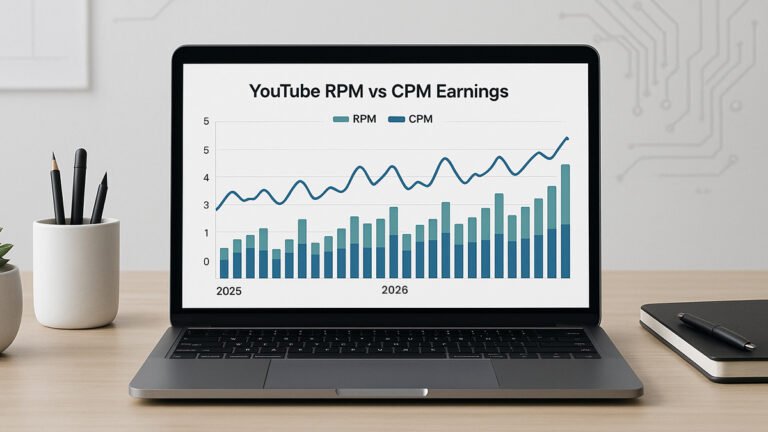Introduction
If you’re a YouTube creator, one of the biggest challenges is dealing with YouTube Copyright Rules. Many beginners upload videos without knowing that using someone else’s music, video clips, or images without permission can lead to their content being flagged, demonetized, or even removed. Copyright issues can also result in strikes, which may put your entire channel at risk.
This guide will help you understand the basics of copyright on YouTube, how to avoid violations, and what to do if you receive a copyright claim. Whether you’re new to this or have experience, understanding these rules is crucial for protecting your channel and building a sustainable career on YouTube.
What is Copyright?
Copyright is a legal protection that gives creators ownership over their original work. This includes:
- Music (songs, beats, background tracks)
- Videos (movies, TV shows, clips)
- Images, graphics, and artwork
- Written content (scripts, articles, lyrics)
When you use copyrighted material without permission, you risk violating YouTube’s Copyright Policies.
YouTube Copyright Rules Explained
1. Copyright Strikes
A copyright strike happens when the copyright owner submits a valid takedown request against your video. If your video contains their material and you didn’t have permission, YouTube may remove it.
- 1 strike – Warning and temporary restrictions
- 2 strikes – More severe restrictions (e.g., no live streaming)
- 3 strikes – Permanent termination of your channel
⚠️ Strikes expire after 90 days if you complete YouTube’s Copyright School.
2. Content ID Claims
YouTube uses an automated system called Content ID that scans videos for copyrighted material. If it finds a match, the copyright owner can:
- Monetize your video (they earn money, not you)
- Block your video in certain regions or worldwide
- Track your video performance without taking it down
Unlike strikes, Content ID claims don’t always harm your channel, but they affect monetization.
3. Fair Use on YouTube
Sometimes you can legally use copyrighted material under Fair Use. This applies if your content is:
- Educational (explaining, teaching, or reviewing)
- Transformative (adding commentary, criticism, or parody)
- Non-commercial (not for profit)
However, fair use is complex, and YouTube may still remove your video if the copyright owner disputes it.
4. Public Domain & Creative Commons
- Public Domain: Works that are free for everyone to use (e.g., very old music, books, or images).
- Creative Commons (CC): Content where the creator gives permission for reuse under specific conditions.
On YouTube, you can filter search results to find videos with Creative Commons licenses.
How to Avoid Copyright Issues on YouTube
Here are some proven tips to stay safe:
- Create Original Content – Always prioritize your own recordings, voiceovers, and visuals.
- Use Royalty-Free Music & Sounds – Download free tracks from YouTube Audio Library or licensed platforms.
- Use Stock Footage & Images – Sites like Pexels, Pixabay, and Unsplash provide free-to-use visuals.
- Check Licenses Carefully – Even “free” content may require attribution.
- Use Built-in Tools – Try YouTube’s features like the music swap tool if your video gets a claim.
👉 You can also optimize your uploads with tools like YouTube Tag Generator Free to improve visibility while keeping your videos copyright-safe.
What to Do If You Get a Copyright Claim
Step 1: Review the Claim
Check your YouTube Studio dashboard for details. The claim will tell you which part of your video is affected.
Step 2: Choose an Action
- Accept the Claim: Let the copyright owner monetize or block your video.
- Remove the Content: Replace or mute the copyrighted section.
- Dispute the Claim: If you believe it’s fair use or you own the rights, submit a dispute.
Step 3: File a Counter-Notification (Last Resort)
If your video was wrongly removed and your dispute was rejected, (YouTube Copyright Rules) you can send a counter-notification. But this is a legal step, so proceed carefully.
Best Practices for YouTube Creators
To build a safe and long-term channel, follow these best practices:
- Keep a record of licenses (music, footage, graphics).
- Don’t rely on “no copyright” claims unless verified.
- Always credit creators when required.
- Avoid re-uploading other creators’ videos.
- Stay updated with YouTube’s policies since rules evolve over time.
FAQs About YouTube Copyright Rules
Q1: Can I use 10 seconds of a song without copyright issues?
No. Even short clips of copyrighted music can trigger claims.
Q2: What happens if I get 3 copyright strikes?
Your YouTube channel will be permanently terminated.
Q3: Can I monetize videos with Creative Commons content?
Yes, if the license allows commercial use. Always double-check terms.
Q4: Is background music in public places a copyright issue?
Yes. If copyrighted music is audible in your video, it can still trigger Content ID.
Q5: How can I find free music for my YouTube videos?
Use YouTube Audio Library or royalty-free music platforms.
Conclusion
Understanding YouTube Copyright Rules is essential for every creator who wants to grow without risks. By focusing on original content, using royalty-free resources, and respecting licenses, you can avoid unnecessary copyright issues and keep your channel safe.
Remember: YouTube success isn’t just about views and subscribers—it’s about building a sustainable channel that won’t disappear overnight due to copyright strikes.
So, stay creative, stay original, and take your channel to the next level. Start by protecting your content and optimizing it with tools like YouTube Tag Generator Free—because your hard work deserves to shine!




